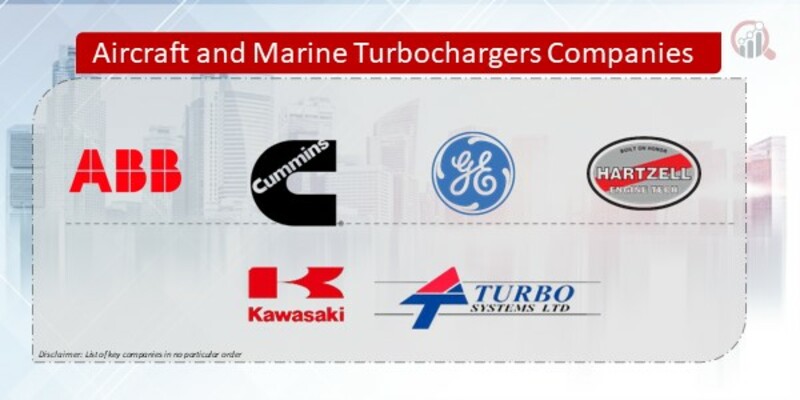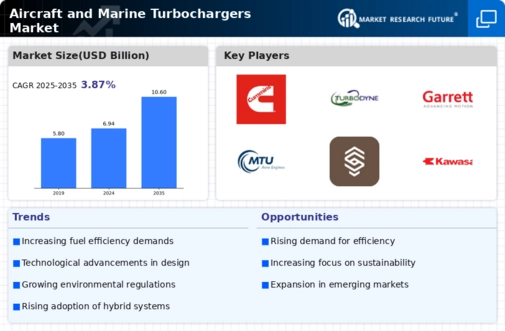Top Industry Leaders in the Aircraft Marine Turbochargers Market

Strategies Adopted Aircraft and Marine Turbochargers Market
- Product Innovation: Key players focus on continuous innovation to develop turbochargers with improved efficiency, reduced emissions, and enhanced durability, meeting stringent regulatory requirements and customer demands for higher performance.
- Market Penetration: Companies employ aggressive marketing strategies, including extensive distribution networks, partnerships with OEMs and aftermarket distributors, and targeted advertising campaigns, to penetrate new markets and expand their customer base.
- Cost Optimization: Cost optimization initiatives such as lean manufacturing, supply chain optimization, and economies of scale help companies improve profitability, reduce manufacturing costs, and offer competitive pricing to customers.
- Aftermarket Services: Offering comprehensive aftermarket services, including maintenance, repair, and overhaul (MRO) services, spare parts distribution, and technical support, allows companies to enhance customer loyalty and generate recurring revenue streams.
Key Players:
ABB (Switzerland)
Cummins (US)
General Electric (US)
Hartzell Engine Technologies (US)
Kawasaki Heavy Industries (Japan)
Main Turbo Systems (US)
Mitsubishi Heavy Industries (Japan)
PBS Velka Bites (The Czech Republic)
Rolls-Royce (UK)
Textron Inc. (US)
Other Prominent Players:
Continental Motors Group (US)
Jrone Turbocharger (China)
Lycoming Engines (US)
Man Energy Solutions (Germany)
Factors for Market Share Analysis:
- Technology and Performance: Turbocharger technology advancements that deliver superior performance, fuel efficiency, and reliability are critical factors influencing market share, with customers prioritizing products that offer the best overall value proposition.
- Industry Standards and Compliance: Compliance with industry standards, emissions regulations, and certification requirements is essential for market acceptance and customer confidence, driving market share for companies with proven track records of compliance.
- OEM Partnerships and Contracts: Establishing strategic partnerships and securing long-term contracts with leading aircraft and marine engine manufacturers enables turbocharger suppliers to gain significant market share and secure a stable revenue stream.
- Customer Relationships and Reputation: Building strong customer relationships, providing exceptional service and support, and maintaining a positive reputation for quality and reliability are key factors in retaining existing customers and attracting new ones, driving market share growth.
Industry News:
- Regulatory Compliance Updates: News regarding updates to emission regulations, fuel efficiency standards, and industry certifications impact turbocharger manufacturers' product development strategies and market positioning.
- OEM Contracts and Partnerships: Announcements of OEM contracts, partnerships, and collaboration agreements highlight market expansion opportunities and the competitive landscape's evolving dynamics.
- Technological Advancements: Reports on technological advancements, such as variable geometry turbochargers, twin-scroll turbochargers, and electric turbochargers, showcase innovation trends driving market growth and competitiveness.
- Market Expansion Initiatives: News of market expansion initiatives, including investments in production facilities, distribution networks, and aftermarket services, indicate companies' efforts to strengthen their global presence and competitiveness.
Current Company Investment Trends:
- Research and Development: Investments in research and development (R&D) to develop next-generation turbocharger technologies, materials, and manufacturing processes drive innovation and differentiation, enhancing companies' competitive positions.
- Sustainability and Environmental Responsibility: Companies are investing in environmentally sustainable turbocharger solutions, including hybrid and electric turbochargers, to meet increasingly stringent emissions regulations and address customer demand for eco-friendly propulsion systems.
- Digitalization and Industry 4.0: Adoption of digitalization technologies, including predictive maintenance, remote monitoring, and data analytics, improves operational efficiency, reduces downtime, and enhances customer service, contributing to companies' competitiveness.
- Market Diversification: Diversification into new application areas, such as renewable energy, industrial machinery, and power generation, reduces dependence on traditional markets and creates growth opportunities in emerging sectors, driving competitive advantage.










